Hey Pluto, it’s great to see your face! Since sending its last batch of images in April, NASA’s New Horizons probe lopped off another 20 million miles in its journey to the mysterious world. Among the latest revelations: the dwarf planet displays a much more varied surface and the bright polar cap discovered earlier this spring appears even bigger.
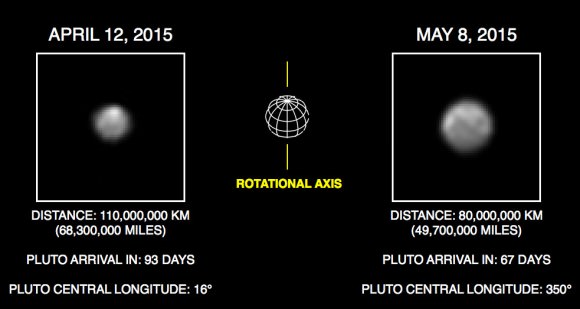
“These new images show us that Pluto’s differing faces are each distinct; likely hinting at what may be very complex surface geology or variations in surface composition from place to place,” said New Horizons Principal Investigator Alan Stern, of the Southwest Research Institute in Boulder, Colorado.
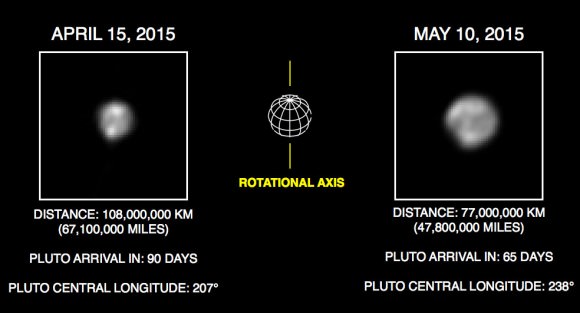
Mission scientists caution against over-interpreting some of the smaller details. The photos have been processed using a method called deconvolution, which strips away the out-of-focus information to enhance features on Pluto. Deconvolution can occasionally add “false” details or artifacts, so the smallest features in these pictures will need to be confirmed by images taken from closer range in the next few weeks.
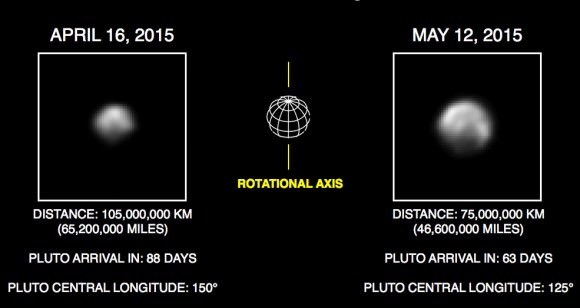
Compared to recent photos of Ceres, the other dwarf planet in the limelight this season, Pluto shows only light and dark blotches. That’s how Ceres started out too. All those variations in tone and texture suggest a fascinating and complex surface. And it’s clear that the polar cap — whatever it might ultimately be — is extensive and multi-textured. The images were taken from a little less than 50 million miles (77 million km) away or about the same distance Mars is from Earth during a typical opposition.
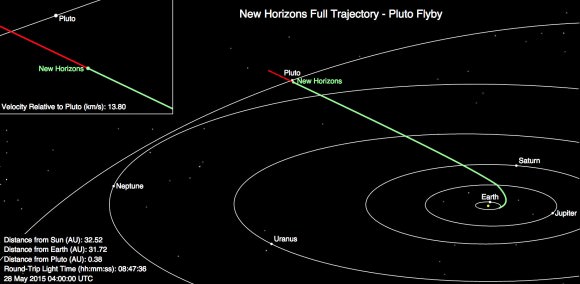
Watch for dramatic improvements in the images as New Horizons speeds toward its target, covering 750,000 miles per day until closest approach on July 14. By late June, they’ll have four times the resolution; during the flyby that will improve to 5,000 times. The spacecraft is currently 2.95 billion miles from Earth. Light, traveling at 186,00o miles per second, requires 8 hours and 47 minutes – the length of a typical work day – to make the long round trip.

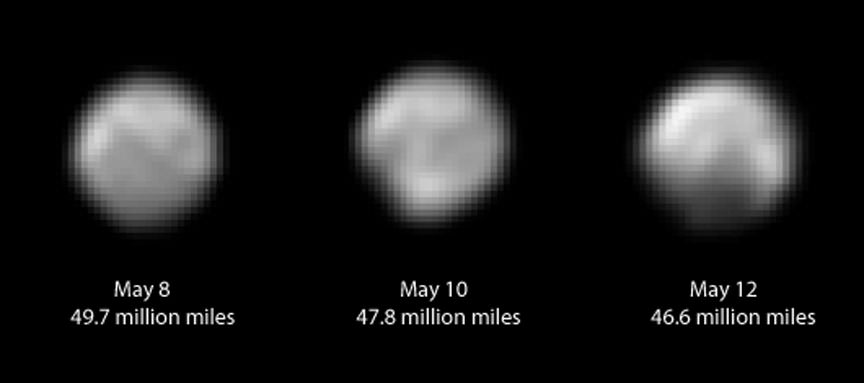
Would tidal interaction with Charon warm Pluto and Charon each to have enough warmth for a subsurface ocean?
Steven,
Excellent question! Currently, Pluto and Charon are tidally locked to one another where one hemisphere of Charon always faces Pluto and vice versa. Much earlier however, tidal stresses were inevitable as the two bodies evolved to their current configuration. It seems reasonable to assume that tidal forces then would have generated internal heat. Enough to create a subsurface ocean? Maybe?
Reading around a bit I see some predictions – see http://www.iflscience.com/space/subsurface-ocean-pluto
To add to and clarify what Bob said, no, tidal interaction isn’t warming Charon and Pluto. Why? Because there isn’t any tidal interaction… at least not anymore. The two are now tidally locked, which means they’ve “used up” (so to speak) the potential tidal energy that they use to have.
Because the two now face each other all the time, they no longer “drag” against each other tidally, so no heating occurs. Any subsurface oceans are thus likely long frozen over, unless some other energy source (like radioactive decay) is keeping them warm.
Well, there will still be tiny perturbations caused by the other moons. A similar thing, I think, is what stops tidal forces on Titan and Europa from winding down. I doubt Pluto’s other little moons are enough to do very much though.
Fascinating. Many people have said that Triton is something like Pluto’s twin, but it does not seem to have the dramatic albedo variations that Pluto does. It will be interesting to see Pluto up close at last.
These images show the process that made the images from the Charon-Pluto eclipses during Pluto’s equinox was fairly accurate . Though it does seem obvious Pluto’s surface is dynamic so there will be some changes. I’m curious if the nitrogen frost that causes the polar cap will obscure underlying surface features or just appear as icy highlights.
When you look at these features, you won’t call Pluto a dwarf planet anymore but a full blow planet as it should be.
Nah it won’t do that. But it (along with Ceres) will prove that dwarf planets rock! (or icy-rock or something like that)
But Pluto has a complete moon system unlike those puny little dwarf planets like Vesta or Ceres.
The tidal locking could also provide enough energy for a water sea.
Vesta doesn’t make the dwarf planet cut.
I don’t think having a satellite is a good criterium for planethood. The reason is many asteroids are binary as well and massive Venus is also moonless.
Vesta and Pallas should probably have their own category between asteroid and dwarf planet. Some on the Dawn mission have suggested designating them as protoplanets.
Complete moon systems do not make dwarf planets “full-blown” planets. Moon systems have nothing to do with defining a planet.
No, being in hydrostatic equilibrium is what makes dwarf planets full blown planets.
Dwarf planets ARE full blown planets. That was the intention of Alan Stern when he coined the term–to create a third class of planets in addition to terrestrials and gas giants.
There are far more than 3 planet classes. http://en.wikipedia.org/wiki/List_of_planet_types
Yes, if you include exoplanets. However, the wikipedia list does not include dwarf planets, which it should.
WATCH OUT. I have heard rumors that Pluto and its gang of family members is set to destroy our probe. WHY? Because we demoted it.
So fascinating to begin to see up close what was only a single point of light when I was a kid. Hoping we get through this in one piece.
What a great time to be alive! Think of all the ‘firsts’ our generation has witnessed. That list would be extensive so I won’t even attempt it. Suffice it to say, here comes another first! YES! “You’ve come a long way baaaby!”
Too bad the encounter will be but a fleeting glimpse. But it’s possible that in our lifetimes(?) we’ll see an orbiter head toward Pluto and Charon and Styx and etc.? Depends on what New Horizon’s finds..
How was Pluto’s system of longitudes created? On what basis did they decide that, OK, such-and-such a meridian was 0 degrees longitude?
Jagged,
0 degrees longitude was set on the hemisphere of Pluto that always faces the tidally locked moon Charon.
This is tangible proof that scientists are really smart.
Unless Pluto has a trick up its sleeve and and is not really tidally locked. Maybe moves a couple of meters per year.